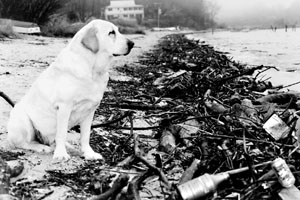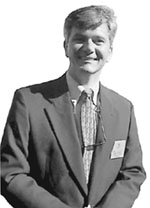
Dock of the Bay

Volume VII Number 5
February 4-10, 1999
Big Dam Problem: Bay Besieged
by Conowingo Debris
Litter on the beach: It's a dog-gone
shame.
That malt liquor bottle that floated up on your
beach along the Chesapeake Bay on Sunday might have been tossed out in New
York and delivered courtesy of a company in Philadelphia.
The adage "we all live downstream" never rang truer in the Middle Bay as we endure thousands of tons of driftwood and debris being let go from behind the crest gates at Conowingo Dam near the Pennsylvania border.
The dumping into the Chesapeake Bay is a rite of early spring brought on by rising waters in the Susquehanna River, which stretches north into New York. The Conowingo Dam, which generates electricity, is operated by PECO Energy Co. of Philadelphia.
But seldom has the flow come at us this early and this heavy, which PECO acknowledges.
"Other than January of '96, this is probably more debris than we've seen on the river than any time in the last 10 years," said PECO spokesman Michael Wood.
The debris swirling on the Chesapeake and washing up on beaches in the Annapolis region has generated navigation warnings from the Coast Guard along with questions about the responsibility of a corporation to engage in dumping practices that could send private citizens to jail.
The debris largely is wood, from twigs to entire trees. But it also includes 55-gallon metal drums, tires and building materials with rusty nails and jagged glass. Along Herring Bay, the debris was 10 feet wide and two feet high in places; one tiny swath of beach that was pristine last Saturday by Tuesday morning had a half-dozen beer or soda bottles, two oil containers, a milk jug, numerous hunks of polystyrene and one plastic tampon applicator.
While Bayfront communities will find kindling easy to come by, they also will be needing to organize work crews to clean up the mess.
The massive Conowingo Dam spanning the Susquehanna is a half-mile wide with 11 generating turbines. Above Conowingo there are three more dams controlling the river flow. The Conowingo becomes the collection point for all of the debris and garbage that flows into the valley of the mighty Susquehanna. That is the debris now washing up on our beaches.
When the flow of the river exceeds 85,000 cubic feet per second at Conowingo, PECO opens some of the 52 crest gates to lower the river and relieve the pressure.
On Tuesday, January 26, that flow reached 255,000 cubic feet per second, prompting a series of openings on 11 of the gates, said PECO spokesman Wood.
The extreme flow derives from abundant winter snowfall in Pennsylvania and New York and the region's heavy rains of January. The strong flow continues; by mid-week, PECO still had three or four gates open, meaning that Chesapeake navigation will remain treacherous and we will see new junk on our beaches in the coming weeks.
PECO has an underwater screen, called a trash rack, that catches some of the debris. The utility spends about $100,000 a year removing junk, Wood said.
But this time of year, the utility stops using its barges and other clean-up equipment because of the dangers of the fast-moving water.
"We make a good faith effort throughout the year to remove the debris, but during these high flow periods, it becomes very challenging to stop debris from passing," Wood said. "From a safety perspective, we can't have anybody out on the river."
Don't expect to see PECO executives from Philadelphia walking your beach with trash bags. And don't expect much help from the Maryland Department of Natural Resources either.
In 1996, Natural Resources Police operated a hotline to monitor reports of problems. But this year, DNR has no money for either a hotline or for assistance with shoreline clean-ups, said Susan O'Brien, a DNR spokeswoman.
O'Brien asserted that the recent trash build-up is due partly to the recent lunar high tides. "It's still navigable and Natural Resources Police are patrolling the waters," she said. "It's a seasonal event, nowhere near the amount of debris of 1996."
Baysiders may be finding that bending over to pick up trash on their beaches is a seasonal event, too, one that stretches from winter into spring.
-BL
In Crash Aftermath, More Driver Training Urged
They happen far too often, the crashes that steal our youngest lives. A community weeps; crosses and flowers mark the spot of the tragedy. Then loved ones go forward with an ache in their hearts. Almost always there is a nagging sense that the horrible, fateful moment could have been prevented.
The accident in Calvert County last week that killed three teens is one that may live on in people's memory. It is generating calls from General Assembly members and advice from experts to better prepare teens to get behind the wheel.
In the most recent Calvert crash, three Patuxent High School students died near Chesapeake Ranch Estates when the yellow 1998 Mustang in which they were riding crashed head-on into a U-Haul truck. They were on their way home from school in the middle of the afternoon.
The victims were Michael Vito, 17, Jaqueline Rose, 14, and Rachel Thomas, 14.
A day after the accident, two members of the Southern Maryland Delegation to the General Assembly, George Owings (D) and Anthony O'Donnell (R), wrote to Gov. Parris Glendening suggesting that the state consider a precautionary program for teen drivers.
"During Vietnam, it was said that we lost our innocence. Now, we are losing our innocents," they wrote. "Sadly, we have done little to prepare our young drivers to handle the weapon now in their possession."
The delegates want their colleagues to study the feasibility of beefing up driver's training with a simulator. "Kids are typically taken out in the middle of the day when it's dry and there's little or no traffic. That's not the reality of driving today," Owings told New Bay Times.
"This technology allows for the setting - urban or rural, the type of vehicle and weather conditions to be programmed in. It gives an experience they cannot possibly get elsewhere. We use simulators in training pilots and astronauts, but here is a basic life skill we keep missing the boat on," the Calvert-Anne Arundel Democrat said.
During the week of Feb. 22, a Salt Lake City company will be in Annapolis to demonstrate how the simulator works. It's a big thing - 35 feet long, 12 feet high and 10 feet wide - and undoubtedly expensive. Owings said that at this stage, he doesn't know how many would be needed, where they would be used or how they would be paid for.
But, the delegates wrote, "This has got to stop. We are heartsick over going to funerals where we are saying good-bye to our young."
Meanwhile, author Phil Berardelli, author of Safe Young Drivers: A Guide for Parents and Teens, said that the crash calls attention to the need for better instruction. His book is a course for beginners and their parents with step-by-step instructions covering all driving skills.
Driver's education is not part of the curriculum in Maryland schools, though it's required before young drivers can be licensed.
Berardelli, who lives in northern Virginia, notes that between 6,000 and 7,000 teens die on U.S. roads each year. Age 16 - when driver's licenses are issued - is by far the most dangerous age.
Berardelli says that driver's education courses, public or private, offer instruction that falls far short of the 100 hours or so that it takes to properly teach young people to drive. It's up to parents to make sure kids know what they're doing, he says, even if that means denying them a license at age 16.
"When I tell parents that they don't have to let their children drive, they can't believe I'm saying that. Some of them don't want a confrontation," he said.
Berardelli offers tips on teaching teens to drive: www.safeyoungdrivers.com.
-NBT
Around and About
Anne Arundel County Councilman John Klocko (R-Crofton), the only
member returning to the seven-seat governing body after November's elections,
may notice a lingering shadow after his Groundhog Day remarks to the newly
formed Deale Merchants Association.
NBT's follow-up canvas turned up three reasons Klocko should have stayed
in his burrow.
The second-term councilman earned a few boos from the otherwise restrained audience, plus a lot of smoldering indignation when, after greeting the crowd of 175 en Française, he quipped "now I'm down in Deale." The reference was to how far he'd come from that morning in Crofton, when he'd greeted a group of French exchange teachers.
Klocko put his foot in his mouth again when he urged citizens to get involved by applying for their Small Area Planning Committees - four days after the deadline.
Finally, the councilman missed a grand chance to redeem himself when he failed to ask the gathered business people what was on their minds.
The answer would have been a lot. With three supermarkets and attendant shopping centers suddenly vying to open up in Deale and nearby sleepy Bayside communities, feelings are high and polarized.
"Irrelevant," said community activist Ann Wolfe, summing up Klocko's contribution.
-SOM
Virginia's garbage notes: A sprawling landfill in the southeastern part of the state purchased by Waste Management Inc., the world's biggest disposal company, has the capacity to become the second largest dump in America, the Richmond Times-Dispatch reported this week. That would be fitting for the nation's second biggest garbage importer ...
In Pennsylvania, a new video camera bought from the proceeds of a convicted polluter will monitor garbage dumps around Philadelphia ...
In Mississippi, they've found another reason
why smoking can be dangerous. Biloxi authorities say that a fire
that burned several acres in the city this week may have started when a
bird picked up a lighted cigarette. Either that or fire inspectors have
bird-brained ideas ...
In Spain, animal rights activists are angry once again after a northern village performed their annual ritual of hurling a goat from the church belfry in honor of a patron saint. Pepa, a black female goat, was described as shaken but unscathed after the 50-foot plunge ...
Our Creature Feature is a tale from New York City about a squiggly thing that you may not know about - gribbles. No, gribbles aren't what Bowery drunks feel climbing up their pants legs or what Wall Street wizards get in their gut before stock deals.
Gribbles, also known as limnoria, are shrimp-like animals that burrow into submerged wood. Until recently, the gribbles have been content munching old timber at the bottom of harbors. But with anti-pollution laws kicking in, they're multiplying and turning their attention to the pilings that keep New York from sliding into the sea.
The state plans to spend $6 million to study the gribbles which, in the end, could turn out to be more serious than a drunk's DTs or a tycoon's bad nerves.
| Issue 5 |
Volume VII Number 5
February 4-10, 1999
New Bay Times
| Homepage |
| Back to Archives |